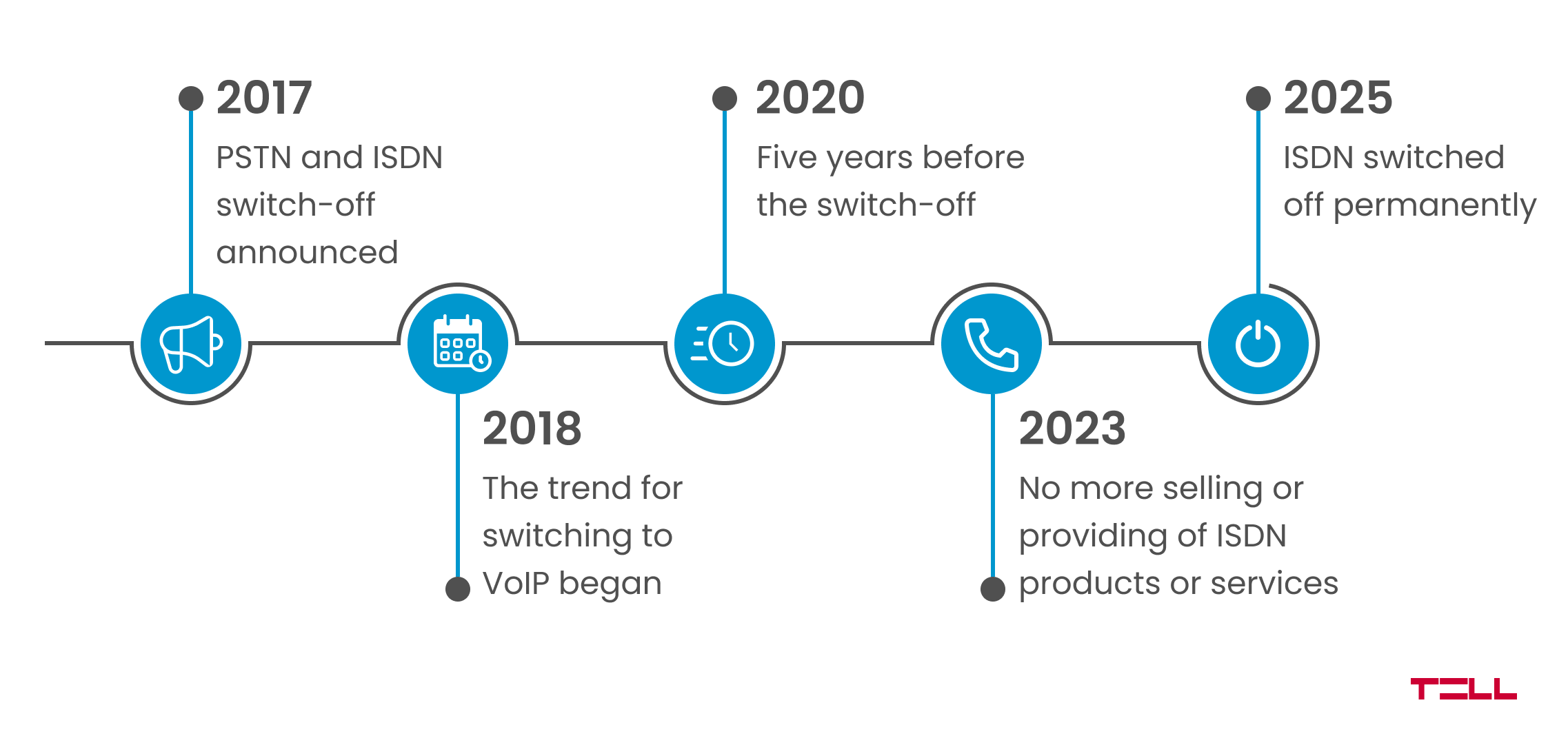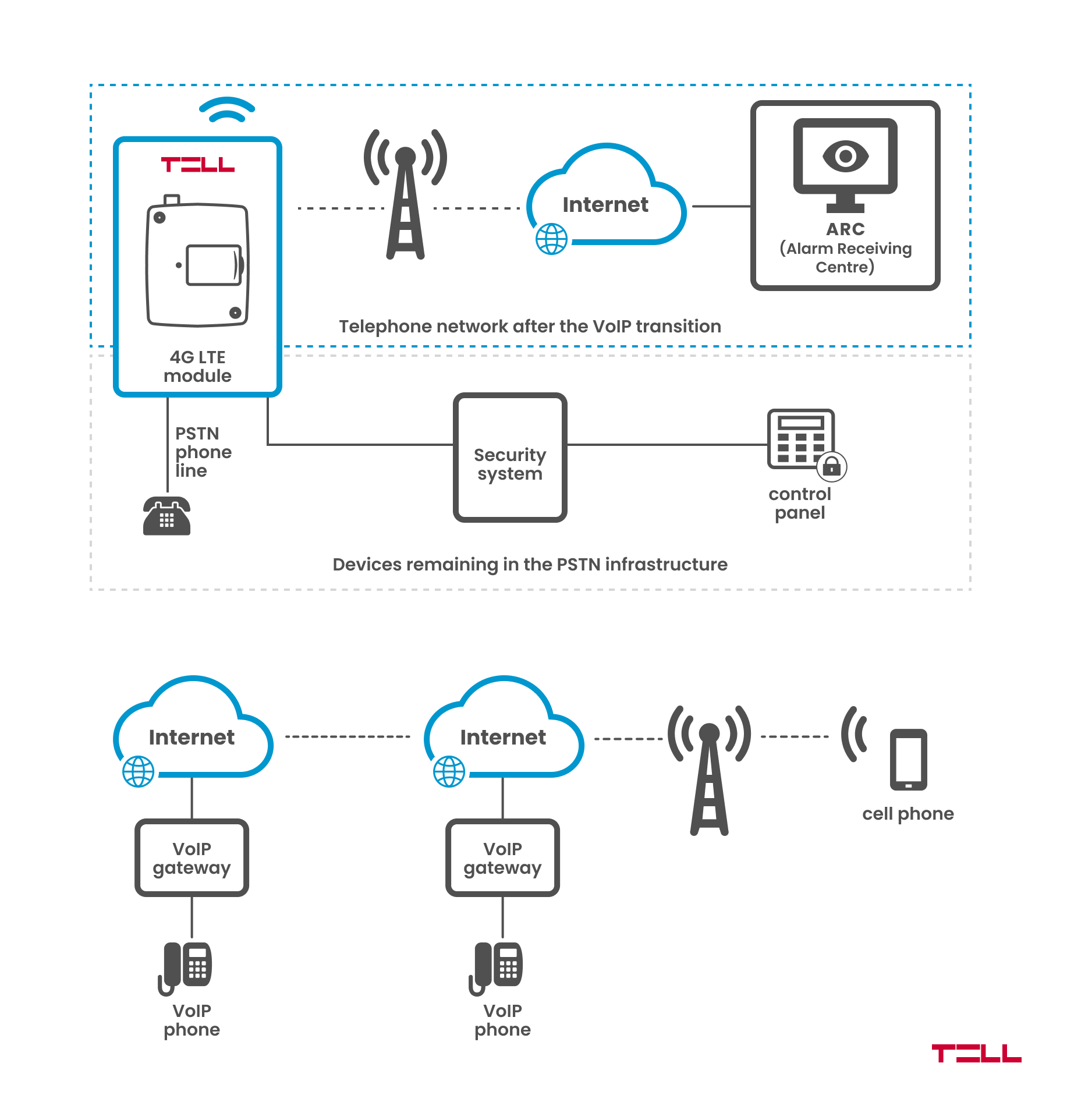Navigating the PSTN Switch Off: Challenges and Innovative Solutions on how to Replace It

The impending shutdown of the United Kingdom's and Ireland’s Public Switched Telephone Network (PSTN) by the end of 2025 marks a significant transformation in the nation’s telecommunications infrastructure. The move from the traditional PSTN to a modern Voice over Internet Protocol (VoIP) system is driven by the necessity to replace aging copper cables with more efficient and reliable fibre optic technology. This transition, while crucial for embracing digital developments, poses numerous challenges that affect (the operation of those technical devices which, by their design, are not suitable for connecting to the VOIP network), the adaptability of users, and the broader digital divide.
However, solutions like TELL Adapter2 and TELL Ecoline PRO can replace the discontinued PSTN lines with a technical solution that has the same parameters as traditional PSTN lines, ensuring the uninterrupted operation of existing devices for all users.
Why is the transition necessary?
The PSTN has been a cornerstone of the UK's and Ireland’s communication, supporting not just voice but also broadband services via ADSL and FTTC technologies. However, the global shift towards digital networks necessitates this transition to VoIP, which promises enhanced efficiency and service quality. Countries like the Netherlands and Estonia, having already made this transition, exemplify the potential benefits and increased capabilities of a fully digital network.

The challenges of PSTN shutdown
Emergency service reliability: The dependency of VoIP on continuous power supply and stable internet connections raises significant concerns regarding the reliability of emergency services during critical times. Traditional PSTN systems, despite their obsolescence, provided a reliable means of communication under various conditions, a benchmark that VoIP must meet.
Compatibility issues with legacy systems: Many existing infrastructures, including alarms, CCTV, and emergency systems, rely on PSTN lines. Transitioning these systems to operate via VoIP involves complex compatibility adjustments and potential equipment replacements, which can be costly and disruptive.
Costs: The question of which devices need to be replaced or supplemented after the transition often does not arise. Replacing a device used for making phone calls is easy and usually not problematic. However, integrated systems that previously operated using the PSTN network may only be replaceable at high costs. For example: alarm systems, PSTN PBX phone systems, intercom systems, and other devices suitable for M2M communication.
Financial and logistical challenges: The shift has significant financial implications for both providers and consumers. Upgrading to compatible equipment and ensuring that all systems are VoIP-compatible requires substantial investment, which can be burdensome for small businesses and individual users. Furthermore, these replacements might not be justified since the systems function perfectly; only their communication pathways need to be replaced due to the discontinuation of PSTN services.

The solutions to replace PSTN: Adapter2 and Ecoline PRO
TELL offers devices suitable for replacing PSTN lines. Universal communicators like Adapter2 and Ecoline PRO emulate a "phone line" with the same technical parameters as the PSTN line. As a result, your well-functioning devices can continue to be used as usual, such as:
- Signaling devices, alarm system, and technical equipment: If you have an alarm system that previously relied on a telephone line, Adapter2 and Ecoline PRO are excellent for replacement purposes, as they ensure these systems continue to function seamlessly.
- Specialized alert functions: These devices are particularly useful for critical signaling applications like fire alerts, where signals are sent to a central receiving station, ensuring continuous protection and safety.
TELL Ecoline PRO
Ecoline PRO processes the signals from the alarm control panel and is capable of transmitting them to remote monitoring receiver devices in the form of IP communication. The device comes with a multiplatform application where the signals are also forwarded via Push notifications, and the relay output of the device can be controlled.
TELL Adapter2
In Adapter2, signal communication includes IP communication, voice calls, SMS, email, and Push notifications. Additionally, the outputs of the Adapter2 can be activated via SMS and voice calls.
Suitable for the remote control, programming, and monitoring of existing alarm systems
Both devices are capable of creating a transparent serial port, making alarm systems or technical devices equipped with a serial port accessible through a 4G LTE connection. Besides status queries, remote programming and configuration of the devices are also possible. For example, alarm control panels can be programmed with their own programming software.
The modules can send status signals to the TELL monitoring receiver unit in their own communication format, displaying technical statuses, voltage levels, signal strength, identifiers, and SIM data on the monitoring receiver. The presence of the connection is ensured by continuous test transmission, quickly revealing any potential network outage or disconnection.
Practical steps for end users
- Consult with experts: Contact your alarm system installer, telephone PBX installer, intercom system installer, and other professionals who manage devices currently communicating over PSTN lines.
- Get a TELL module: It is important to start the transition even before the discontinuation, ensuring a seamless switch without downtime.
Practical steps for installers and retail companies
1. Assess the systems: Identify how many systems currently operate on PSTN lines, such as alarm system monitoring, PBX systems, and technical signaling devices.
2. Get TELL modules and Begin the transition: It is crucial to start this process before the discontinuation, ensuring a seamless switch without downtime and making the replacement and scaling of PSTN lines more manageable.
3. Monitoring: Set up monitoring for the status signals of TELL devices as needed, allowing you to continuously track device operations and intervene immediately in case of a technical fault. TELL devices can send tests for connection presence, transmit technical signals, and display signal strength and voltage status in the monitoring software.
4. Expand your services and revenue: By using these devices not only for line replacement but also for signal transmission, you can expand your services and increase revenue. With TELL modules, the system can send alerts not only to monitoring systems but also to smartphones via SMS and PUSH notifications, resulting in service expansion and additional profit.
5. Support remote programming: TELL modules have serial port outputs, so if you previously programmed remote devices via telephone lines, you don't have to give up this functionality. TELL modules can create a transparent serial port, making remote programming and status monitoring possible for devices with serial port support.
These steps ensure a smooth transition from the discontinued PSTN infrastructure to modern, VoIP-compatible systems while minimizing financial and logistical burdens.
Embrace the change, replace PSTN
As the UK and Ireland moves towards a digital-only telecommunication environment, embrace the transition from PSTN to VoIP with confidence and proactivity. While seeking alternative products to replace the PSTN, it's essential to start considering your options now. Delaying this decision could lead to disruptions in the functionality of your alarms and signaling devices down the line. Act promptly to ensure a seamless transition and uninterrupted operation of your critical systems.
Need more information? Contact us!
